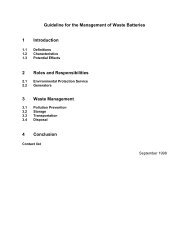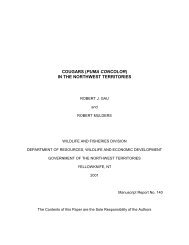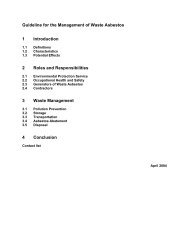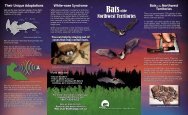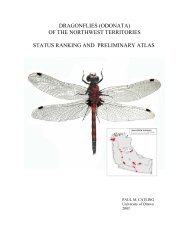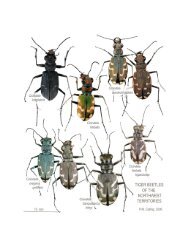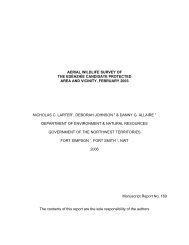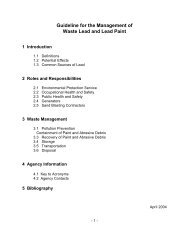Standard Operating Procedure (SOP) - Environment and Natural ...
Standard Operating Procedure (SOP) - Environment and Natural ...
Standard Operating Procedure (SOP) - Environment and Natural ...
- No tags were found...
You also want an ePaper? Increase the reach of your titles
YUMPU automatically turns print PDFs into web optimized ePapers that Google loves.
<strong>St<strong>and</strong>ard</strong> <strong>Operating</strong> <strong>Procedure</strong> (<strong>SOP</strong>)<br />
Capture, H<strong>and</strong>ling & Release of Bears<br />
Wildlife Care Committee Primary Author: Dr. Marc Cattet Version 2 - 2011<br />
In most situations, allow 10-15 minutes to elapse between the time<br />
of injection of the first dart <strong>and</strong> injection of the second dart (Kreeger<br />
et al. 2002, Reynolds et al. – unpublished report). During this time,<br />
effort should be taken to avoid unnecessary stimulation of the target<br />
animal, <strong>and</strong> allow the drug time to act. For example, when darting<br />
from a helicopter, the pilot should move the helicopter as far as<br />
possible from the animal while still allowing visual monitoring for<br />
drug effects. Alternatively, if the bear is darted while restrained by a<br />
leg-hold snare, the capture crew should move away from the<br />
immediate area <strong>and</strong> observe the bear at a distance with binoculars.<br />
If the bear continues to run at full speed despite this, it may be<br />
necessary to deliver a second dart sooner to avoid hyperthermia. If<br />
the animal shows some drug effect, but does not go down, readminister<br />
50% of the original dose. However, if the animal shows<br />
no drug effect within 5 minutes following the first dart, re-administer<br />
the entire original dose.<br />
• If there is no evidence of drug effect after two darts, the<br />
immobilization effort should be aborted in the case of helicopterassisted<br />
capture, or temporarily ceased with snared bears, as this<br />
strongly suggests a problem with either the drug delivery system<br />
(e.g., failed injection, needle too short) or the drug quality (e.g.,<br />
inappropriate storage or formulation).<br />
Nevertheless, the animal should be visually monitored from a safe<br />
distance to determine the extent of drug effects. For a snared bear,<br />
it may be necessary to mix a new volume of drug or modify the<br />
delivery system before another attempt is made to anesthetize the<br />
animal. For a free-ranging bear, although there should be no further<br />
attempt at capture that day, effort should be made again over the<br />
next 24 hours to relocate the animal <strong>and</strong> assess its status.<br />
• If a target animal is lost following darting, effort must be made to<br />
track the animal <strong>and</strong> assure its safety without compromising<br />
human safety.<br />
Capture crews may sometimes also use remote delivery of reversal<br />
drugs in situations where they are unable to safely approach or<br />
reach a drugged target animal.<br />
• Whenever possible, effort should be made to find darts that miss<br />
their target.<br />
This is particularly important in areas frequented by humans, such<br />
as in urban settings or areas with regular human use where there is<br />
potential for someone to find a “lost” dart.<br />
• Capture of more than one bear per capture event (e.g., adult<br />
female with dependent offspring, breeding pairs) must be<br />
attempted only if there are enough personnel in the capture crew<br />
to ensure that each animal can be continuously observed <strong>and</strong> its<br />
physiological function monitored closely throughout the h<strong>and</strong>ling<br />
period.<br />
8



